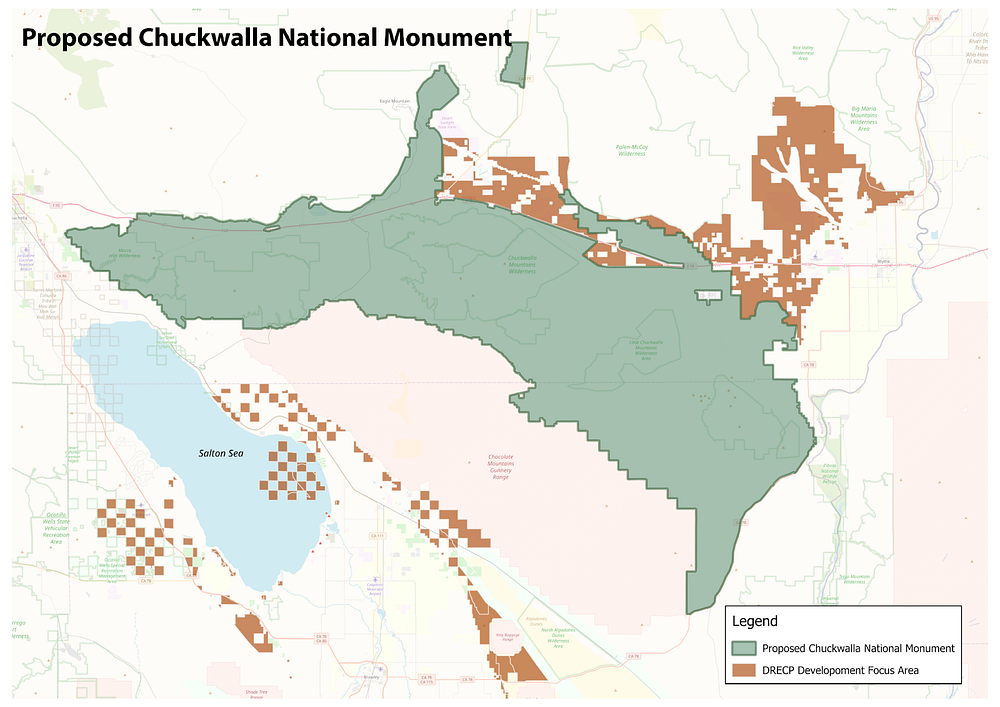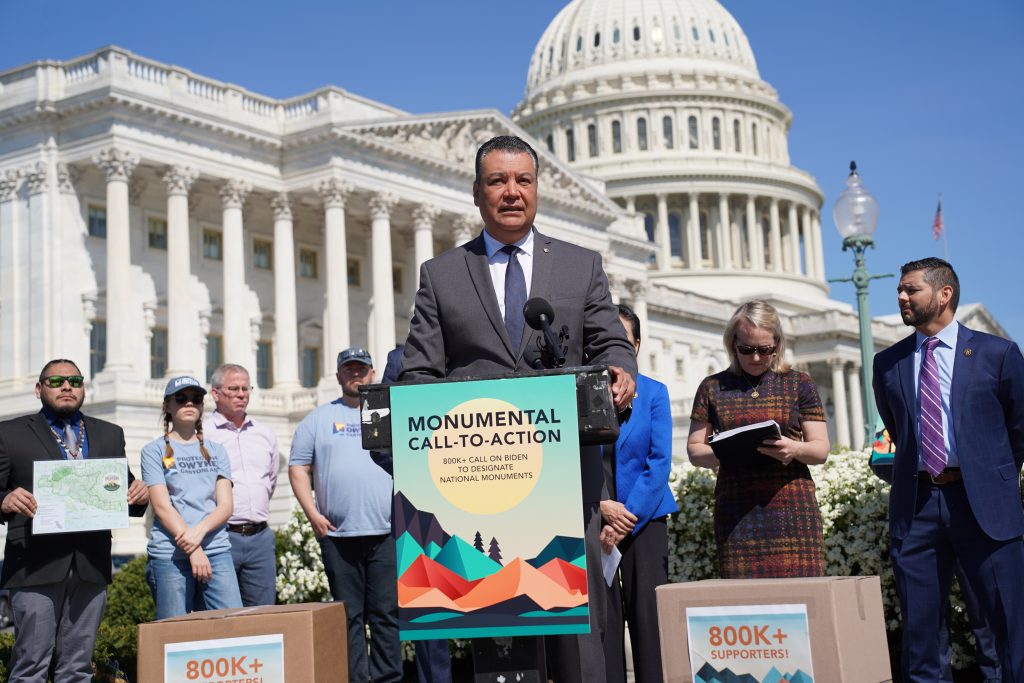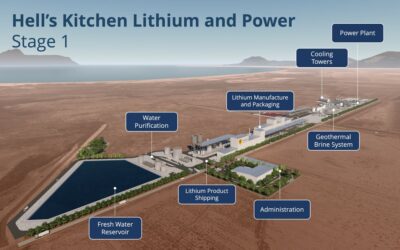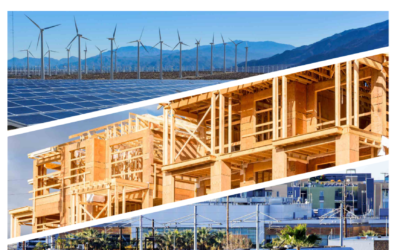The Chuckwalla National Monument proposal, a pivotal conservation initiative in the California desert, has gained substantial traction, drawing support from tribal leaders, key elected officials, and community members.
On Saturday, May 18, Secretary of the Interior Deb Haaland visited the lands, held a roundtable discussion meeting with Tribal leaders, and interacted with more than 700 local community advocates who showed up in support of the proposal.
Approximately one month before Haaland’s visit, U.S. Senators Alex Padilla and Laphonza Butler (both D-Calif.) and Representative Dr. Raul Ruiz (D-Calif.-25) announced bicameral legislation to create the Chuckwalla National Monument and expand Joshua Tree National Park. The bill aims to safeguard approximately 627,000 acres of public lands adjacent to Joshua Tree National Park, stretching from the Coachella Valley to near the Colorado River. The Joshua Tree National Park expansion would encompass approximately 17,915 acres of previously designated public lands, as recommended by the National Park Service.

The proposed Chuckwalla National Monument map.
The lawmakers also submitted a joint letter to President Biden urging him to use the Antiquities Act to designate the proposed monument.
“Establishing the Chuckwalla National Monument across California’s vast desert landscape would help us fight the climate crisis, protect critical wildlife corridors, preserve sacred tribal sites, and improve equitable access to nature for our local communities,” said Senator Padilla. “Our proposal reflects the input of tribal leaders who have fought for years to protect these sacred landscapes and from our partners in the energy industry who worked with us to carefully craft the Monument’s boundaries to ensure we can meet our shared clean energy goals. I look forward to working alongside federal officials, tribes, veterans, and local businesses to secure these protections as soon as possible.”
“I am honored to introduce the Chuckwalla National Monument Establishment and Joshua Tree National Park Expansion Act of 2024 alongside California U.S. Senators Alex Padilla and Laphonza Butler. I am particularly proud of the collaboration and leadership from a robust coalition, including local tribal leaders, conservationist groups, members of the renewable energy industry, utility companies, community organizations, and youth leaders. They have built the necessary momentum and agreements to ensure this project’s success,” said Dr. Ruiz. “The Chuckwalla National Monument is good for the environment, the economy, and the public’s health. It aims to protect pristine wildlife habitats, endangered plants and animals, and sacred sites of significant spiritual importance to local tribes, which are crucial for their cultural preservation. Additionally, it will enhance tourism and economic opportunities in our region and provide a new venue for constituents to hike, bike, and enjoy the breathtaking landscapes and natural beauty of our desert. This monument will play an important role in addressing California’s and our nation’s climate change goals while promoting the growth of renewable energy. I am thrilled that we have reached this milestone together and call on President Biden to use the Antiquities Act to expedite the creation of the monument.”

Senator Alex Padilla and Congressman Raul Ruiz promote their legislation at the U.S. Capitol on April 16, 2024
“This bill protects a remarkable natural area in our state with important cultural sites and sensitive ecosystems,” said California Natural Resources Secretary Wade Crowfoot. “Designating this area as a National Monument will protect these important lands while boosting outdoor access for communities across the region. I’m proud to support tribal leaders and community-based organizations who driving this effort, and thank Senator Padilla and Congressman Ruiz for championing this important proposal.”
Cultural and Environmental Significance
The proposed monument is a living testament to the region’s rich cultural heritage and environmental diversity. It includes lands that have been home to the Torres Martinez Desert Cahuilla Indians and other indigenous tribes for thousands of years. This deep-rooted history and the diverse ecosystem are what make this region unique and worth preserving.
The lands within the proposed national monument include the homelands of the Iviatim, Nüwü, Pipa Aha Macav, Kwatsáan, and Maara’yam peoples (Cahuilla, Chemehuevi, Mojave, Quechan, and Serrano nations). Designating the Chuckwalla National Monument would help to protect important spiritual and cultural values tied to the land, such as multi-use trail systems established by Indigenous peoples, sacred sites and objects, traditional cultural places, geoglyphs, petroglyphs, pictographs, and native plants and wildlife.
“For thousands of years, the Torres Martinez Desert Cahuilla Indians have called the lands in the proposed Chuckwalla National Monument home,” said Chairman Thomas Tortez Jr. of the Torres Martinez Desert Cahuilla Indians. “We strongly support the designation of the Chuckwalla National Monument and thank Senator Alex Padilla and Representative Raul Ruiz for championing this effort.”
The proposed monument also aligns with California’s ambitious climate goals. Protecting these lands would contribute to state and federal commitments to conserve at least 30% of public lands and coastal waters by 2030. This conservation effort would benefit species such as the chuckwalla lizard, desert tortoise, and desert bighorn sheep.
Community and Economic Benefits
According to supporters, designating the Chuckwalla National Monument would preserve the environment and provide significant community and economic benefits. Popular trails and landmarks such as Painted Canyon, Box Canyon, Corn Springs Campground, and the Bradshaw Trail would be protected, ensuring equitable access to nature for residents of the Eastern Coachella Valley and surrounding areas.
“The Eastern Coachella Valley community came out to show their strong support for designating the Chuckwalla National Monument,” said Frank Ruiz, Director of Audubon California’s Desert and Salton Sea Programs. “As our communities face the impacts of climate change, this is a critical step in protecting the special places that both people and birds need.”
The proposed national monument has garnered diverse local support, including from current and former local elected officials, the Fort Yuma Quechan Indian Tribe, the Torres Martinez Desert Cahuilla Indians, the Twenty-Nine Palms Band of Mission Indians, the Chemehuevi Indian Tribe, the Colorado River Indian Tribes, the Cahuilla Band of Indians, the cities of Banning, Cathedral City, Desert Hot Springs, Indian Wells, Indio, Palm Desert, and Palm Springs, businesses, Chambers of Commerce, and residents of the eastern Coachella Valley and neighboring areas.
Military and Renewable Energy Considerations
The monument’s designation would also help preserve the California desert’s military history by protecting sites like Camp Young and Camp Coxcomb, used by General Patton during World War II. Additionally, the proposal supports the Desert Renewable Energy Conservation Plan (DRECP), which identifies areas suitable for renewable energy development and conservation. “The Chuckwalla National Monument will protect environmental resources and tribal lands while creating an energy corridor for the electric power lines essential for the state’s clean energy future,” said Pedro J. Pizarro, President and CEO of Edison International.
Critics argue that the monument’s designation could limit economic development opportunities and restrict access to public lands for certain uses. However, supporters counter that the boundaries were specifically drawn to avoid conflicts with renewable energy development and other critical economic activities.
Opposition and Challenges
Despite the overwhelming support, there is some notable opposition to the proposal from various stakeholders. Critics argue that designating such a large area as a national monument could limit opportunities for economic growth, particularly in industries such as mining, agriculture, and renewable energy development.
Opponents worry that the restrictions associated with national monument status could impede future economic projects and access to valuable natural resources. For instance, the mining industry has expressed concerns that the monument designation could restrict access to mineral deposits, leading to a loss of jobs and economic opportunities in the region.
Local ranchers and farmers have also voiced their opposition, fearing that the monument status could limit their access to grazing lands and water resources. “Our livelihoods depend on the ability to use these lands for agriculture and livestock,” said a local rancher at a recent public meeting. “The designation of the Chuckwalla National Monument could severely impact our operations and the local economy.”
While the monument’s supporters argue that the boundaries were drawn to avoid conflicts with renewable energy projects, some in the renewable energy sector remain skeptical. They worry that the designation could complicate the permitting process for new solar and wind projects, potentially delaying the development of much-needed renewable energy infrastructure.
There are also concerns about public access and recreational use of the lands. Critics argue that the national monument designation could lead to increased regulation and restricted access for activities such as off-roading, hunting, and other recreational uses. “We understand the need to protect these lands, but we also believe in responsible and sustainable use,” said a representative from a local off-road vehicle club. “A balanced approach that allows for both preservation and recreation is essential.”
Representative Ken Calvert (R-CA 41st District) has expressed reservations. “The designation of the Chuckwalla National Monument must be carefully considered to ensure it does not hinder economic development or limit access to public lands for multiple uses,” said Rep. Calvert. “We must find a balance that protects the environment while supporting our local economies.”
Supporters’ Counterarguments
In response to these concerns, supporters of the monument emphasize that the proposal has been crafted to avoid conflicts with key economic activities. They argue that the monument boundaries were specifically drawn to exclude areas identified as suitable for renewable energy development under the Desert Renewable Energy Conservation Plan (DRECP).
Furthermore, they point to studies indicating that national monument designations can boost local economies through increased tourism and outdoor recreation. “Protecting these lands will not only preserve our natural and cultural heritage but also attract visitors and support local businesses,” said Senator Alex Padilla. “The economic benefits of conservation far outweigh the potential drawbacks.”
Moving Forward
As the debate continues, both supporters and opponents of the Chuckwalla National Monument are making their voices heard. The decision now rests with the federal government, which must weigh the potential benefits of conservation against the concerns of local stakeholders. The outcome will have significant implications for the future of land management and economic development in the California desert.
As the push for the Chuckwalla National Monument continues to gain momentum, with Senator Padilla, Representative Ruiz, and other leaders urging President Biden to use the Antiquities Act to expedite the designation. This 1906 law allows presidents to designate federal public lands, waters, and cultural and historical sites as national monuments through a Presidential Proclamation.
“Our proposal reflects the input of tribal leaders who have fought for years to protect these sacred landscapes,” said Senator Padilla. “The Chuckwalla National Monument is good for the environment, the economy, and the public’s health.”
The fate of the Chuckwalla National Monument now rests in the hands of the federal government.




